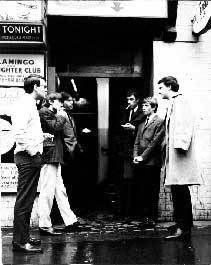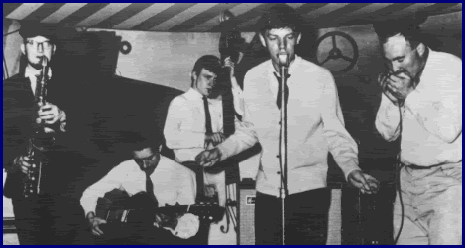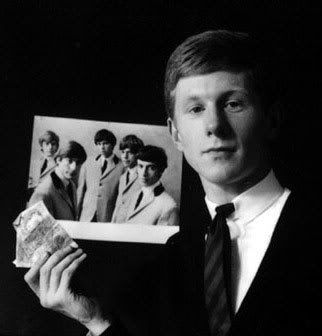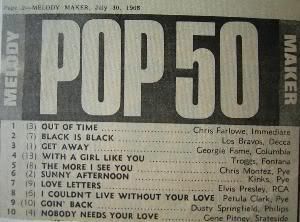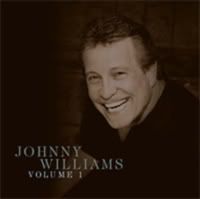 It was their most intimidating audience to date.
It was their most intimidating audience to date.As they entered the Co-Op Ballroom in Nuneaton, Mick Jagger, Keith Richards, Charlie Watts, Brian Jones, Bill Wyman and Ian Stewart did not know what to expect. Tension was high. They set up, were introduced, and began to play their brand of rhythm and blues...
The audience, mostly children from the age of 4 to 10, were not impressed, and proceeded to pummel the Rolling Stones continuously with cream cakes until they left the stage.
"They did not appreciate r&b", said Bill Wyman sadly, looking back on that ordeal.
For the fledgeling r&b band, success and recognition was not coming easy. It was all very well to play at The Marquee on the nights when Blues Incorporated were unavailable, but other venues and appreciative audiences were still very thin on the ground.
But, in 1963, while the Stones searched for gigs and practiced being jammy dodgers, the r&b scene that had grown around the clubs of London was now spreading. The Ealing Club grew from 100 members the first week to 200 memebers the next, to over 800 by the end of 1962, some having wandered to its doors in search of the blues from as far away as Scotland. By 1964, most of the clubs of Wardour Street and West London had gone over to featuring r&b over modern jazz. The Stones finally found a home away from the Marquee, this time in Richmond, at the Crawdaddy Club. Richmond could boast a number of other venues turning to r&b, such as the Eel Pie Hotel, The Station Hotel, The Imperial, and L’Auberge. Approximately 10,000 people were likely to enter the doors of these London clubs alone in a typical week to pick up the r&b sounds.
And the trend had spread outside the capital. By late 1963, rhythm & blues clubs were forming all over: from St Andrew's Hall in Norwich, the Olympia in Reading, the R&B Club in Andover, the Rhythm & Blues Club at the Maritime Hotel in Belfast, and the Downbeat Club and Club A-G0-Go in Newcastle, to the Starlight Rooms in Brighton. It must be said, however, that while now these clubs were bringing r&b closer to British youth, they are all situated in ports, near American bases or close to London.
Rhythm and blues was going to be the new musical wave, then, after all. It had not been inevitable, or even likely. But for a number of reasons, r&b now appealed. It is often suggested that this was simply because Britain was still haunted by the spectre of World War II, and had a yearning for the trappings of America. Yet as my dad told me recently, there had been a number of reasons why rock and roll had become adulterated and tamed in its British version by the early 60s:
But, in 1963, while the Stones searched for gigs and practiced being jammy dodgers, the r&b scene that had grown around the clubs of London was now spreading. The Ealing Club grew from 100 members the first week to 200 memebers the next, to over 800 by the end of 1962, some having wandered to its doors in search of the blues from as far away as Scotland. By 1964, most of the clubs of Wardour Street and West London had gone over to featuring r&b over modern jazz. The Stones finally found a home away from the Marquee, this time in Richmond, at the Crawdaddy Club. Richmond could boast a number of other venues turning to r&b, such as the Eel Pie Hotel, The Station Hotel, The Imperial, and L’Auberge. Approximately 10,000 people were likely to enter the doors of these London clubs alone in a typical week to pick up the r&b sounds.
And the trend had spread outside the capital. By late 1963, rhythm & blues clubs were forming all over: from St Andrew's Hall in Norwich, the Olympia in Reading, the R&B Club in Andover, the Rhythm & Blues Club at the Maritime Hotel in Belfast, and the Downbeat Club and Club A-G0-Go in Newcastle, to the Starlight Rooms in Brighton. It must be said, however, that while now these clubs were bringing r&b closer to British youth, they are all situated in ports, near American bases or close to London.
Rhythm and blues was going to be the new musical wave, then, after all. It had not been inevitable, or even likely. But for a number of reasons, r&b now appealed. It is often suggested that this was simply because Britain was still haunted by the spectre of World War II, and had a yearning for the trappings of America. Yet as my dad told me recently, there had been a number of reasons why rock and roll had become adulterated and tamed in its British version by the early 60s:
"You have to remember, for a lot of people, even young people, rock and roll had been connected with the Teds. Many ordinary people thought they were violent, dangerous thugs. They were outcasts, troublemakers from the working class [so people assumed]... So a lot of people wanted nothing to do with anything these troublemakers enjoyed. In any given week, at least half of the Hit parade would be filled up with ballads and popular tunes by people like Alma Cogan. That's what most people wanted to hear, right up to the mid Sixties."
In fact, Britain benefitted from a veneer of prosperity and more spending power in people's pocket, largely due to the removal of rationing and a series of canny devaluations by the MacMillan government during the late 50s. More and more young people were growing up into a comfortable suburban life that had cultural, educational and creative advantages. There was more money for instruments, more opportunity to enjoy the nightlife, the chance for free university education and growing enrollment at art schools. Here, a relatively small number of young people were introduced to jazz and then the blues, and had a chance to play and experiment. So affluence, leisure time and money in pockets was making it possible to adopt new American trends, after a fashion, in a way that had never truly happened in Britain before.
Some have said that in fact it was easier for British youth to take up r&b than it was for their contemporary white Americans. This is perhaps an oversimplification, as it ignores the way southern soul in particular was formed interracially in Memphis and Muscle Shoals, to name but two examples. However, naively obsessed with all things American, with access to far fewer media accounts of the realities of American society, British youth were far happier than white Americans to simply accept that jazz, blues and r&b was at the heart of 'American' music. The main objection to r&b in Britain was its noisiness, young people's unprofessional musicianship and the length and cleanliness of the bands' hair.
Was the music that they made r&b? It was certainly different to the rhythm & blues Americans were used to, They couldn't play as well, they couldn't sing at all American, and they had nobody to refer to except for the twenty or so records they had in their bedroom. They had grown up with very different influences to their black American heroes, from skiffle, to old folk ballads, to music hall songs, and these influences naturally permeated the songs that they began to write for themselves. So ultimately, British r&b changed into something unlike its beginnings, and took a course far removed from the course of black American music in the late 60s and 70s. But it was inspired by and dedicated to the seven-inch pieces of vinyl they had listened to note for note in those early years...
Some have said that in fact it was easier for British youth to take up r&b than it was for their contemporary white Americans. This is perhaps an oversimplification, as it ignores the way southern soul in particular was formed interracially in Memphis and Muscle Shoals, to name but two examples. However, naively obsessed with all things American, with access to far fewer media accounts of the realities of American society, British youth were far happier than white Americans to simply accept that jazz, blues and r&b was at the heart of 'American' music. The main objection to r&b in Britain was its noisiness, young people's unprofessional musicianship and the length and cleanliness of the bands' hair.
Was the music that they made r&b? It was certainly different to the rhythm & blues Americans were used to, They couldn't play as well, they couldn't sing at all American, and they had nobody to refer to except for the twenty or so records they had in their bedroom. They had grown up with very different influences to their black American heroes, from skiffle, to old folk ballads, to music hall songs, and these influences naturally permeated the songs that they began to write for themselves. So ultimately, British r&b changed into something unlike its beginnings, and took a course far removed from the course of black American music in the late 60s and 70s. But it was inspired by and dedicated to the seven-inch pieces of vinyl they had listened to note for note in those early years...
SO, who was playing this r&b hybrid? Time for some more music posts!
Information quoted from the chapter 'Enter The Stones' in 'White Heat: A History of Britain in the Swinging Sixtes' by Dominic Sandbrook, and 'Mod: A Very British Phenomenon' by Terry Rawlings. Blue Eyed Handsome Dad helped with some memories also!
NOTE TO READERS: Tomorrow I am starting to move house. So I have to wait for a few days to get my internet reconnected in the new flat. So I apologise in advance if there is a delay in posting more stuff next week. Of course, since I usually get sidetracked and delayed anyway, you may not notice any difference to the usual poor service ! :)


